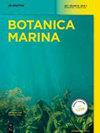Laurencia mediterranea sp. nov. (Ceramiales, Rhodophyta) from the central Mediterranean Sea
IF 1.4
4区 生物学
Q2 MARINE & FRESHWATER BIOLOGY
引用次数: 1
Abstract
Abstract The identification of macroalgal species within the Laurencia complex is challenging, due to the presence of inconspicuous morphological characters, extensive variation in these traits and a diverse biogeography. Moreover, for a number of these species, no DNA sequence data are available in online databases. For this study, five algal specimens, tentatively assigned to Laurencia , were collected from Malta in the central Mediterranean Sea and studied using an integrative systematics approach. An analysis of the data resulted in the description of a new species, Laurencia mediterranea using combined morphological and molecular criteria, including COI-5P and rbc L. Morphologically L. mediterranea sp. nov. was distinct from other Laurencia spp. in the type of holdfast, the colour and shape of the thallus, the presence of secondary pit connections, lenticular thickenings and ‘corps en cerise’ . Moreover, a new genetic species cluster indicated a separate taxon at the species level. Our study demonstrates that genetic sequences having clear links to sample metadata and digital herbaria are indispensable for macroalgal biodiversity research. This approach could offer a solution for algal taxonomy in cases where biogeography is important and limited sequence data exist in online DNA libraries.地中海中部的Laurencia mediterranea sp. 11 .(陶瓷,红水螅)
由于存在不明显的形态特征,这些特征的广泛变化以及生物地理的多样性,在劳伦西亚复合体内鉴定大藻物种是具有挑战性的。此外,其中一些物种的DNA序列数据在在线数据库中是不可用的。在本研究中,从地中海中部的马耳他收集了5个藻类标本,并采用综合系统学方法对其进行了研究,暂定为劳伦西亚。利用形态学和分子结合的标准,包括COI-5P和rbc L.对这些数据进行了分析,结果发现了一个新种——地中海月桂属(Laurencia mediterranea)。从形态学上看,地中海月桂属与其他月桂属植物在持壳类型、菌体的颜色和形状、次生坑连接的存在、透镜体增厚和“corps en cerise”等方面都有所不同。此外,一个新的遗传种簇在种水平上显示了一个独立的分类单元。我们的研究表明,与样本元数据和数字植物标本库有明确联系的基因序列对于大型藻类生物多样性研究是必不可少的。这种方法可以为生物地理学重要且在线DNA文库中序列数据有限的藻类分类提供解决方案。
本文章由计算机程序翻译,如有差异,请以英文原文为准。
求助全文
约1分钟内获得全文
求助全文
来源期刊

Botanica Marina
生物-海洋与淡水生物学
CiteScore
4.10
自引率
4.50%
发文量
43
期刊介绍:
Botanica Marina publishes high-quality contributions from all of the disciplines of marine botany at all levels of biological organisation from subcellular to ecosystem: chemistry and applications, genomics, physiology and ecology, phylogeny and biogeography. Research involving global or interdisciplinary interest is especially welcome. Applied science papers are appreciated, particularly when they illustrate the application of emerging conceptual issues or promote developing technologies. The journal invites state-of-the art reviews dealing with recent developments in marine botany.
 求助内容:
求助内容: 应助结果提醒方式:
应助结果提醒方式:


